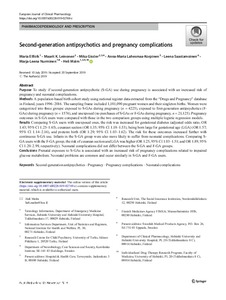Second-generation antipsychotics and pregnancy complications
Maria Ellfolk; Maarit K. Leinonen; Mika Gissler; Anna-Maria Lahesmaa-Korpinen; Leena Saastamoinen; Marja-Leena Nurminen; Heli Malm
https://urn.fi/URN:NBN:fi-fe2021042825599
Tiivistelmä
Purpose To study if second-generation antipsychotic (S-GA) use during pregnancy is associated with an increased risk of pregnancy and neonatal complications.
Methods A population-based birth cohort study using national register data extracted from the "Drugs and Pregnancy" database in Finland, years 1996-2016. The sampling frame included 1,181,090 pregnant women and their singleton births. Women were categorized into three groups: exposed to S-GAs during pregnancy (n = 4225), exposed to first-generation antipsychotics (F-GAs) during pregnancy (n = 1576), and unexposed (no purchases of S-GAs or F-GAs during pregnancy, n = 21,125). Pregnancy outcomes in S-GA users were compared with those in the two comparison groups using multiple logistic regression models.
Results Comparing S-GA users with unexposed ones, the risk was increased for gestational diabetes (adjusted odds ratio, OR 1.43; 95% CI 1.25-1.65), cesarean section (OR 1.35; 95% CI 1.18-1.53), being born large for gestational age (LGA) (OR 1.57; 95% CI 1.14-2.16), and preterm birth (OR 1.29; 95% CI 1.03-1.62). The risk for these outcomes increased further with continuous S-GA use. Infants in the S-GA group were also more likely to suffer from neonatal complications. Comparing S-GA users with the F-GA group, the risk of cesarean section and LGA was higher (OR 1.25, 95% CI 1.03-1.51; and OR 1.89, 95% CI 1.20-2.99, respectively). Neonatal complications did not differ between the S-GA and F-GA groups.
Conclusions Prenatal exposure to S-GAs is associated with an increased risk of pregnancy complications related to impaired glucose metabolism. Neonatal problems are common and occur similarly in S-GA and F-GA users.
Kokoelmat
- Rinnakkaistallenteet [27094]
